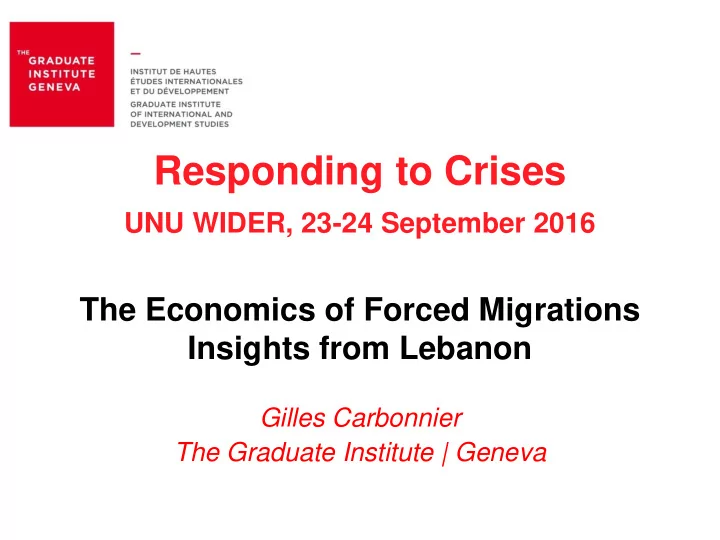

Responding to Crises UNU WIDER, 23-24 September 2016 The Economics of Forced Migrations Insights from Lebanon Gilles Carbonnier The Graduate Institute | Geneva
Red thread Gap between the reality of the Syrian refugee crisis in Lebanon and mainstream (economic) migration theories Gap between international policy discourse and perceptions by host communities Focus on redistributive policies (incl. aid) Taxing benefits and compensating for losses accruing from large, sudden migration 2
An archetypical forced migration crisis >1.2m Syrian refugee influx over 2-3 years, >25% of the population, half of them < 24 years old Open border policy until end 2014, no camps (de facto 44% rental price hike from mid-2012 to mid-2013) VASyR 2013 : For 57% of refugees, primary livelihood source is employment, while 30% reported getting aid and remittances VASyR 2014 : strained relations with host communities As displacement becomes protracted, tensions on the labour market: wages drop with excess supply of unskilled labour. Housing and basic necessities become more expensive. Dysfunctional, sectarian state and weak ‘public’ service 3 delivery
(Economic) migration theories Neoclassical migration models Micro level : Individual assessment of the costs and benefits, of push and pull factors (Ernest Ravenstein’s law of migration, 1885) Migrant make rational decisions, favouring the destination with the higher gains (incl. greater security) and lower costs (travel, living while looking for work, finding a home) Macro level : focus on wage differentials between labour markets and on market regulation New economics of migrations Rational choice made by households (units of production and consumption, culturally defined; Stark & Boom 1985) Minimizing risks and maximizing income (incl. remittances, aid, social benefits, etc.) 4
Structural approaches Focus on structural pull factors such as demand for (3D) jobs, segmented/dual labour markets (Michael Piore, 1979) Demographic shifts: e.g. Africa vs. Europe Political factors (incl. war and disasters; visas and work permits) and social factors (social networks, diasporas, explains the perpetuation of migration patterns over time) World system theories Penetration of capitalist economic relations in pre-capitalistic societies creates a pull factor (Wallerstein, 1974) 5
‘Migration is a win - win’… is it? And for whom? Migration as an engine of poverty alleviation, growth and development Gaps in earnings of production factors relates to marginal factor productivity differentials, incl. ‘non - human’ capital per worker Migration can improve efficiency of world factor use World Bank estimates that the gains from enhanced migrations can result in an income gain of 600% for migrants 6
Disconnect with the literature on forced migration Focus on needs, costs, and the impact of aid (e.g. refugees in Kenya, Pakistan, Lebanon) Assumptions Negative impact of rising prices of basic goods and services, downward pressures on income of unskilled labour, stress on public services and fiscal pressure, environmental degradation Yet, who benefits from higher housing prices, or lower labour costs, and how? Anecdotal evidence e.g. a study on Dadaab refugee camp in 2010: the refugee crisis has brought $14m or 25% of the Province per capita income (livestock and milk sales > $3m), + 1,200 jobs related to the refugee camp 7
The case of Lebanon About half of working-age refugees were active by 2013 (>90% informally; employment ties often predate the Syria crisis) 1/3 increase in labour supply by 2013-14 Daily remuneration of agricultural, construction and domestic workers cut by half or more Women income < 40% men’s Resentment among young unemployed Lebanese youth and host communities Refugees barred from opening new business in 2014, and obligation to renew residence permits against payment Frustration amongst Syrian breadwinners, and greater dependency on shrinking foreign aid 8
The case of Lebanon Few studies on benefits, many on costs Increased demand Refugees may have brought in Lebanon assets worth >$100m by mid-2013 Cash and food voucher programmes injected $800m in the economy in 2013-14. More than 400 shops and supermarkets are involved in the scheme, with two Lebanese banks Greater profit margins In the sectors where wages fell by 50% in just 2 years (agriculture, construction, trade) Landowners and house owners benefit from higher rents 9
Migration as ‘win – lose’ Mixed blessing Low-skilled workers and the poor faces job competition, lower wages, higher prices for essential goods and services Immigrants serve as scapegoats to blame for unemployment and lower wage, insecurity The host country benefits from an influx of resources, skills and foreign aid Higher demand translates in job creation and business opportunities Increase labour supply can free local workforce for higher productivity jobs, and offer greater childcare options to mothers who want or have to work Higher return on capital and lower return on (unskilled) labour 10
Just like for free trade? As for trade, economic theories of migrations highlight the benefit for emigration & immigration countries The mobility of production factors – be it indirectly via trade of goods and services, or directly via labour mobility – tends to improve the efficiency of world factor use As we know yet, free trade has its winners and losers If the overall macro impact is not a zero-sum game – as the theory posits – we can tax part of the gains to compensate for the losses Aid can help Well… how to do this in e.g. Lebanon? Dysfunctional sectarian state, with a designated ‘terrorist organization’ as its most functional component Revise counter-terrorism legislation in donor states and alter the 11 logic of redistribution: how realistic?
To conclude Options for Lebanon Better document costs and benefits on the host state Focus simultaneously on the livelihood of Syrian and Lebanese vulnerable Design and phase out cash assistance for Syrians consistent with social protection for the Lebanese poor, via increased taxation and aid Enforce stronger labour regulation? Safe, affordable remittance channels Tension between integration, incentives to push refugees back home or forward to Turkey/Europe Work in progress… Looking forward to the conversation! 12
Recommend
More recommend